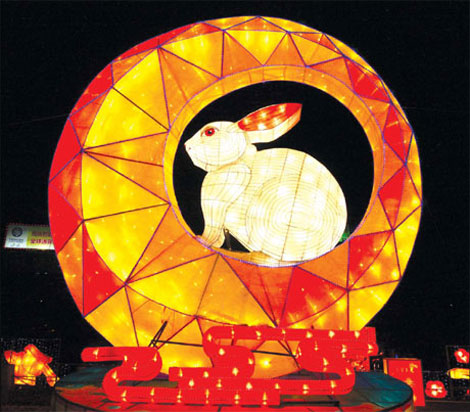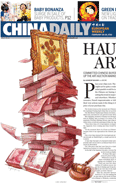The green lantern
Updated: 2011-02-18 11:08
By Liu Lu (China Daily European Weekly)
 |
|
Lantern Festival organizers are using more energy-efficient lighting during this year's events. The lantern above features the Chinese star of 2011 - the rabbit. Cao Zhizheng / For China Daily |
Environmental concerns are shedding new light on a colorful tradition
Every year in China millions and millions of colorful lanterns are hung across the country to raise the Spring Festival atmosphere to its climax. Falling on the 15th day of the first lunar month (Feb 17), the Lantern Festival is the first significant traditional event after Spring Festival and marks the official end of Chinese lunar new-year celebrations.
As well as eating the festival's traditional food yuan xiao, a sweet glutinous rice ball that symbolizes family reunion, the Chinese admire elaborate lantern shows at temple fairs and have fun solving riddles written on the lanterns.
To many, the lantern shows are one of the most anticipated parts of the Spring Festival.
Some Chinese also decorate their houses by hanging up colorful ornamental lanterns of various shapes and sizes.
However, the 2011 Chinese lantern party has seen a major environmental change compared to previous years.
Because of increased public awareness about environmental protection a major green campaign has strongly influenced this year's lantern fairs.
"Low-carbon" and "energy-saving" elements have been injected into light shows, making this time-honored tradition a platform to promote an eco-friendly lifestyle.
In an effort to answer the environmental call, show organizers have incorporated energy efficiency into this ancient cultural tradition.
One such method has been to replace fluorescent lamps with energy-saving lights in order to reduce electricity consumption.
"As the energy-saving concept has gradually became the focus of the public, it has inevitably infiltrated into traditional festivals and greatly influenced the old practice of a variety of folk cultural activities," says Xu Decheng, deputy director of the tourism bureau of Nanjing's Qinhuai district.
Xu is in charge of the Qinhuai Lantern Fair, which is one of China's largest lantern carnivals attracting more than 5 million visitors each year during the Spring Festival period.
According to Xu, more than 80 percent of the 400,000 lanterns on display will be illuminated with LED light bulbs and other types of energy-saving lights reducing energy consumption by nearly 50 percent compared to previous years.
"Despite the high cost of purchasing energy-saving lamps, it will benefit us with substantial savings by reducing electricity fees in the long run," Xu says.
"As well as the high luminous efficiency and good glowing effect of energy-saving lights, their low voltage makes them much safer than ordinary bulbs and more suitable to be showcased at crowded lantern fairs."
To better achieve environment conservation goals, Xu says the tourism bureau also used recycled materials, such as discarded beverage bottles and cans, to make lanterns and decorations.
He says the bureau's green effort has been a talking point among tourists.
"Many visitors are amazed by our stylish green light show and learned the importance of low-carbon life to the sustainable development of our living environment," Xu says.
Local residents have applauded the greening of the Qinhuai Lantern Fair and it appears the eco-friendly trend has been adopted by many other lantern festival organizers, especially in the major cities.
Some environmentalists believe the traditional custom of hanging lanterns in a more environmentally friendly way conforms to the demands of modern social development.
"The hot pursuit of green lanterns reflects Chinese people's rising concern about environment issues," says Song Zhongkui, deputy secretary general of the China Energy Conservation Association.
Song says the association is delighted to find that some organizers have also recycled lights and plan to reuse them for other purposes after the shows.
In previous years the lights would be thrown away after the event wasting a huge amount money, he says.
"The green concept has enriched the meaning of this centuries-old tradition, and is an innovative inheritance and development of traditional culture," Song says.
"It helps to spread the idea of low-carbon life to more households."
Some environmental groups have taken the Lantern Festival as an opportunity to raise the Chinese people's environmental consciousness.
"The Chinese authorities are planning a phase-out timetable for the incandescent lamp," says Li Ang, climate and energy campaigner of Green Peace.
"We fully support the major energy conservation work initiated by the government."
The National Development and Reform Commission says that 65 billion kW of electricity will be saved, if each of the country's 1.3 billion people replaced only one incandescent lamp with an energy efficient one.
"Many European countries have promoted the usage of energy-saving lights, no matter in the home or in public places, and the European Union (EU) has pledged to phase out all incandescent lights by 2012," Li adds.
She urges Chinese local governments to learn from the EU's plan to phase out outdated lights and to show the world China's commitment to emission reduction.
In addition to the use of environmentally friendly lighting, Li says her organization also encourages people to practice other folk customs in an eco-friendly way.
She says electronic fireworks, which plug into a power point or run on batteries and simulate the crackling noises and showering colors of real fireworks, was one way of saving the environment.
"We call on people to replace the traditional fireworks with electronic fireworks, which can not only add the festive atmosphere, but also avoid producing dust, paper scraps and other pollutants," Li says.
"It's not worthwhile that some backward or even dangerous customs cause irreparable damages on environment just in exchange for a beautiful moment."
E-paper

Ear We Go
China and the world set to embrace the merciful, peaceful year of rabbit
Preview of the coming issue
Carrefour finds the going tough in China
Maid to Order
Specials

Mysteries written in blood
Historical records and Caucasian features of locals suggest link with Roman Empire.

Winning Charm
Coastal Yantai banks on little things that matter to grow

New rules to hit property market
The State Council launched a new round of measures to rein in property prices.
